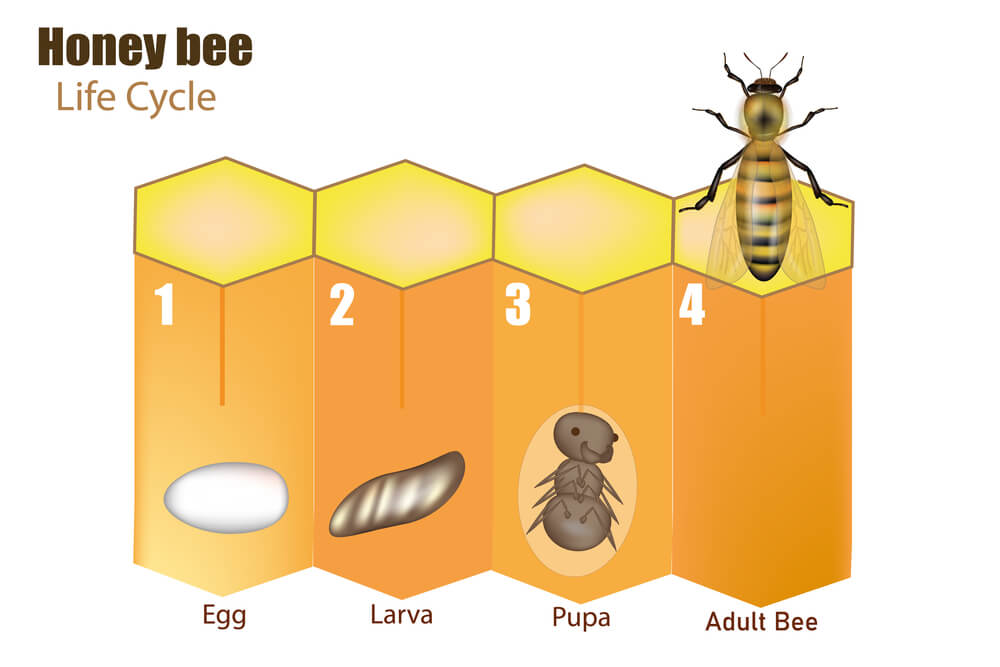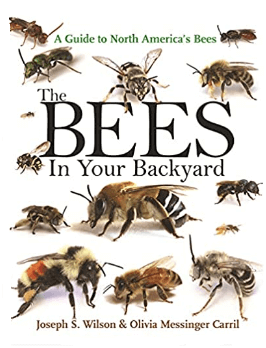Table of Contents:
What Do Bee Eggs Look Like?
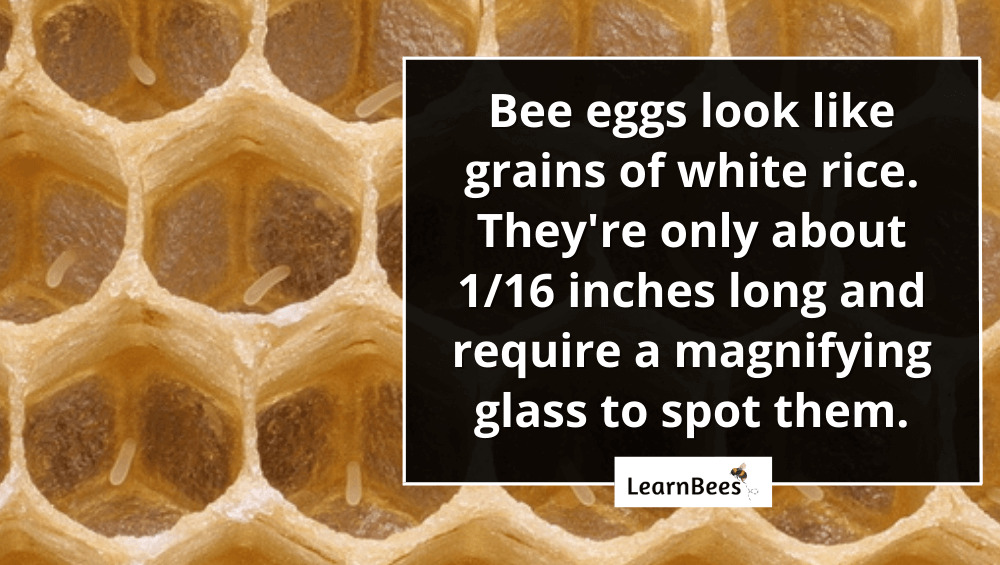
Bee eggs look like grains of rice.
They’re white and only about 1/16 inches long (1.6 mm). Due to their tiny size, the best way to spot them is with a magnifying glass.
And it’s worth mentioning:
In social bee colonies, like in honeybee and bumblebee hives, bee eggs are laid by the queen bee. In solitary bee species, bee eggs are laid by the female bees. Solitary bees are bees that live alone and not inside colonies with hundreds of other bees.
Now here’s the interesting part:
Bee eggs don’t have hard shells like chicken eggs do.
Instead, bee eggs are soft and squishy. This is because the surface of the bee egg is covered by a membrane called chorion. Chorion is a translucent, flexible material that dissolves after about three days.
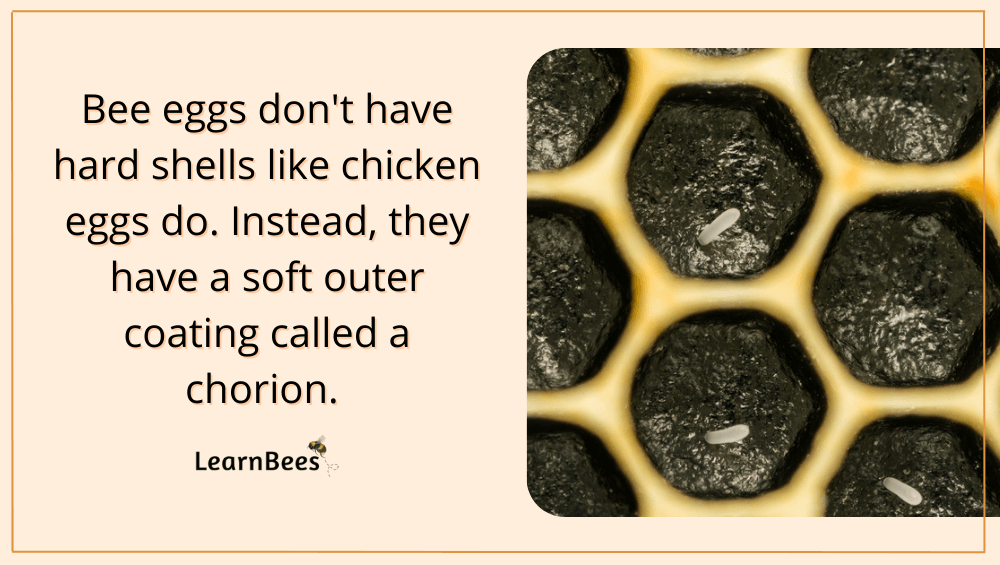
Once the chorion dissolves, the bee enters the second development phase as a bee larva.
But check this out:
There are two different types of bee eggs. The first type of egg is fertilized eggs, which later become female bees. The second type of egg is unfertilized eggs, which develop into male bees.
The queen bee lays more fertilized eggs (female) than unfertilized eggs (male).
Why?
Because female bees are the heavy lifters for the colony. They protect, clean, and build the hive. They also tend to the queen and baby bees by feeding and cleaning them 24/7. Thanks to their hard work, female bees are called ‘worker bees.’
On the other hand, most male bees have one job:
To mate with queens from other hives.
They don’t protect the hive, clean it, or help expand it. As such, male bees aren’t relied upon for the daily activities of the hive, so fewer male eggs are laid.
How Long Does it Take for a Bee Egg to Hatch?
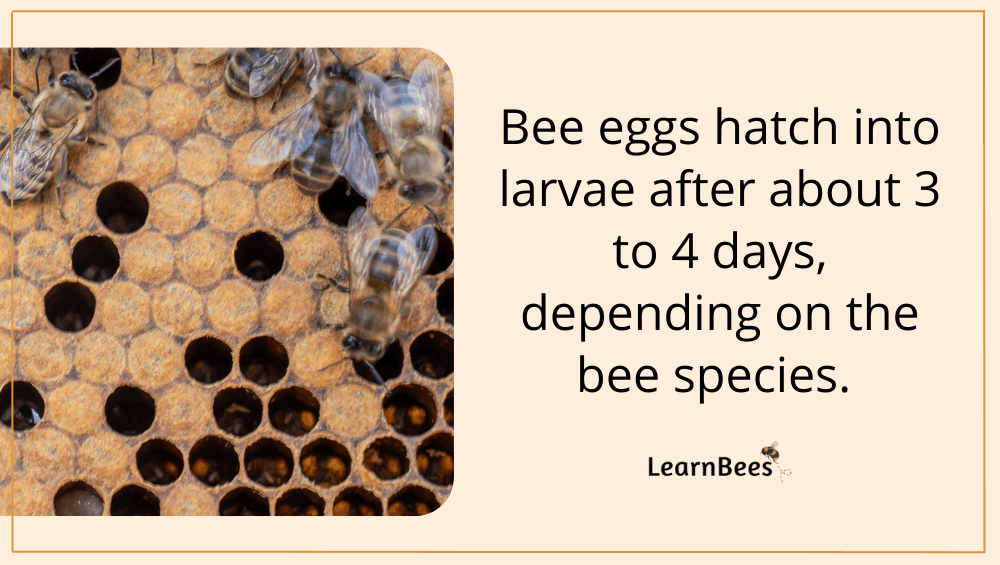
It depends on the bee species.
For example:
It takes about three days for honeybee eggs to hatch. For bumblebees, it takes about four days. There are more than 20,000 bee species, so the time it takes to hatch a bee egg can vary among them.
But here’s the thing:
Bee eggs don’t hatch into adult bees.
Bees actually go through three stages of development before becoming adults. The first stage is the egg, which looks like a tiny grain of white rice. The egg stage lasts three to four days in most bee species. Fertilized eggs become females, while unfertilized eggs become males.
The second stage of development is known as the larva. Bee larva look like small white grubs. They have no legs, eyes, or wings. As the larva grows, it sheds its outer skin several times. The larval stage lasts about six days, depending on the type of bee.
As for the final stage of development?
This is known as the pupa stage. A pupa is the life stage where insects transform into adults. More specifically, the larva spins a cocoon around itself and pupates. Bees stay in the pupa stage for 8-14 days, depending on the kind of bee.
The pupa stage is where the eyes, wings, and legs develop. From there, it officially emerges as an adult bee.
How Many Eggs Do Bees Lay?
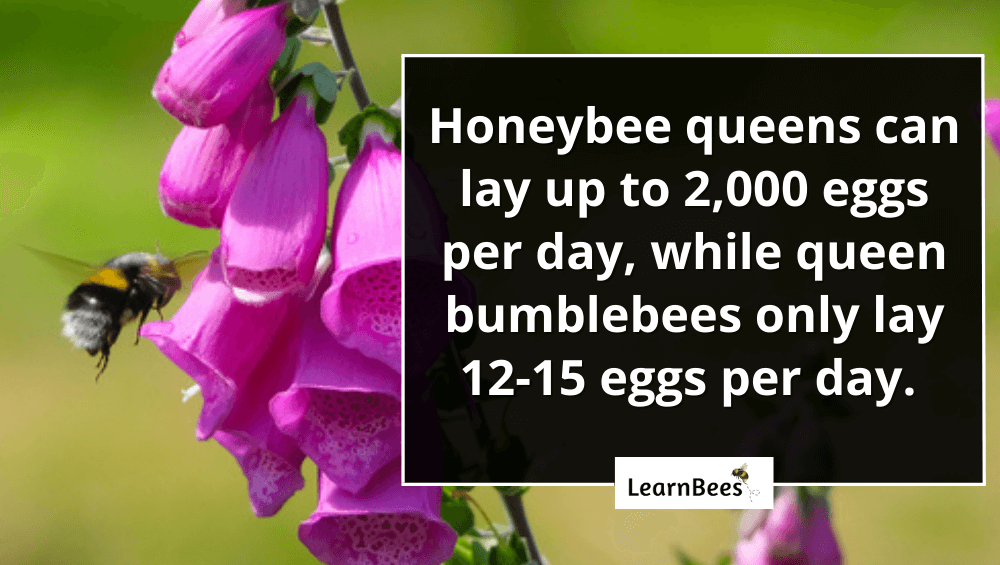
Here’s a fact that might surprise you:
Queen honeybees can lay up to 2,000 eggs in one day. That’s over 200,000 eggs laid each spring and summer.
Other bee species don’t lay quite as many eggs as honeybees do. This is because honeybees live in huge colonies containing as many as 60,000 honeybees. In contrast, bumblebee colonies have up to 400 bumblebees.
Big difference.
But why do honeybees lay so many eggs?
Because honeybees lose a lot of bees each day. For instance, it’s not abnormal for 1,000 worker honeybees to die daily. Worker bees have short lifespans and need to be replaced quickly, so the colony population doesn’t dip too low.
As a result, the queen honeybee spends most of her time laying eggs to ensure the hive’s survival. In return, the queen’s needs are met by the worker honeybees. They feed, clean, and protect her 24/7.
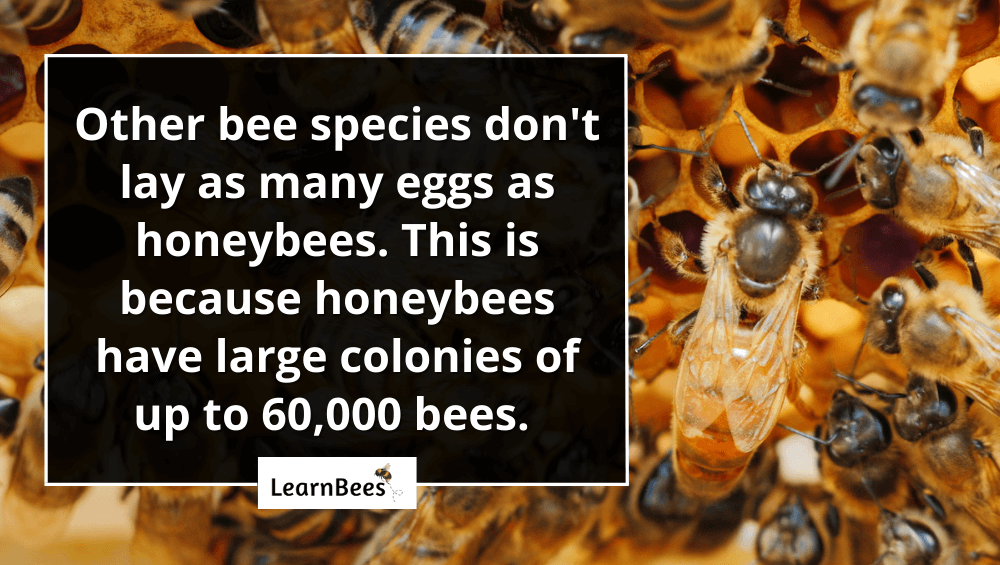
With that in mind:
Other bee species don’t lay as many eggs as honeybees do.
For example, female mason bees may only lay one to two eggs daily. Mason bees are solitary bees, meaning they live alone instead of in colonies. Because of this, they don’t have to worry about laying hundreds or even thousands of eggs to sustain a colony.
But what about bumblebees?
Bumblebees live in much smaller colonies, consisting of 200 to 400 bees. Queen bumblebees are estimated to lay about 12-15 eggs per day during the peak spring and summer season.
But keep in mind:
Not all bee species are as widely studied as honeybees are. As such, we don’t have as much data on the egg-laying habits of many bee species like carpenter bees, sweat bees, and others.
FAQs on Bee Eggs
- How do you identify a bee egg?
- What is a bee’s egg called?
- Where do bees lay their eggs?
- How many eggs does a queen bee lay in one day?
- What color is a bee egg?
- During which month do honey bees lay eggs?
- What do queen eggs look like?
- Is the queen bee the only bee that lays eggs?
- Do bees protect their eggs?
- How long does it take a queen bee to start laying eggs?
- How does a queen bee get pregnant?
- Do bees lay eggs or give birth?
- How long does it take for a bee egg to hatch?
- Do bee larvae look like maggots?
How do you identify a bee egg?
Bee eggs are small and white, about the size of a grain of rice.
For honeybees, you’ll typically see one egg per cell, and it stands straight up on its end at first. Gradually, within the first day or two, the bee egg will tip to one side and lie at the base of the cell. After about three days, the chorion—the soft outer layer of the egg—dissolves, and the new larva is exposed.
Fertilized eggs will become female bees, while unfertilized eggs will become male bees. Unfertilized eggs are laid in special ‘drone cells’, which are larger than those of female bees.
A future queen bee is laid in a special cell known as a queen cell.
After three days, the egg will develop into a larva. The larva looks like a small white grub that doesn’t have any legs, wings, or eyes. Worker bees feed the larvae. They receive ‘royal jelly’ if they’re queens, ‘worker jelly’ if they’re female worker bees, and ‘drone jelly’ if they’re male bees.
—> Go back to the FAQs on bee eggs
More to Explore:
- Do Queen Bees Eat Honey?
- Are Worker Bees Male or Female?
- Queen Bee Versus Worker Bees – How Do They Compare?
What is a bee’s egg called?
In beekeeping, ‘bee brood’ or ‘brood’ are used to describe honeybee eggs, larvae, and pupae.
Many beekeepers use a modern hive called a Langstroth hive with removable frames. The frames where the queen lays eggs are known as brood frames.
—> Go back to the FAQs on bee eggs
More to Explore:
- Do Carpenter Bees Pollinate?
- How Long Do Bumble Bees Live?
- Honeybees vs. Bumblebees: How Do They Compare?
Where do bees lay their eggs?
It depends on the species of bee.
Honeybees, for example, lay their eggs in special cells within the beehive. These cells are known as brood comb, and they’re made of beeswax. A brood comb is constructed into a six-sided shape known as a hexagon. Beeswax is produced by worker bees from wax glands on the underside of their abdomens.
Other bee species may lay their eggs differently than honeybees. For instance, mason bees lay eggs in small holes or cavities in wood, while carpenter bees tunnel into wood to lay their eggs.
—> Go back to the FAQs on bee eggs
More to Explore:
How many eggs does a queen bee lay in one day?
People often ask:
How many eggs do bees lay? How many eggs does a queen bee lay in a year? How many eggs does a queen bee lay in one day?
A queen honeybee can lay up to 2,000 eggs per day during the height of the season. The peak seasons for honeybees are spring and summer. Things start to slow down by late fall as the honeybees prepare to overwinter together as a colony.
The queen honeybee lays so many eggs because she is the only sexually mature female in the colony. So the colony’s future largely depends on her ability to lay eggs. The other bees are either male (drones) or sterile female worker bees.
Plus, female worker honeybees have short lifespans—typically only about six weeks during the summer. It’s not unusual for a honeybee hive to lose 1,000 worker bees daily. So there is a constant need for new bees to be born to take their place.
—> Go back to the FAQs on bee eggs
More to Explore:
- Ground Bees: Are They a Threat to Your Yard?
- Wasps vs. Honeybees: Are They Different?
- Do Bumble Bees Bite?
What color is a bee egg?
Bee eggs are white. They look like white rice grains because they resemble them in shape, size, and color. Bee eggs are only about 1/16 of an inch long.
—> Go back to the FAQs on bee eggs
More to Explore:
During which month do honeybees lay eggs?
Honeybees can lay eggs from March to October, depending on the climate. In more temperament climates like south Florida, honeybees can remain active and lay eggs year round.
Typically, the spring and summer months are when honeybee hives experience the most growth. This is when the queen lays the most eggs, and the colony is at its peak size. During the winter months, the hive slows down considerably. The colony huddles together inside a cluster to remain warm.
—> Go back to the FAQs on bee eggs
More to Explore:
What do queen eggs look like?
Queen honeybee eggs are placed in special cells called queen cells. These elongated vertical cells hang down from the bottom of a frame. The queen cell has a peanut-like shape and stands out amongst the other cells.
When a colony prepares to swarm (split into two separate colonies), the worker bees will begin to build queen cells. This is because the old queen will leave with half the colony to start a new hive elsewhere.
Additionally, a hive will create queen cells when the old queen needs replacing. The queen can need replacing for many reasons, including old age, disease, or injury.
—> Go back to the FAQs on bee eggs
More to Explore:
Is the queen bee the only bee that lays eggs?
The queen bee is the only bee that lays fertilized eggs.
Worker bees can technically lay eggs, but they’re unfertilized eggs that only result in male bees. Unfertilized eggs are known as drones.
The queen bee is the only bee in the colony that is sexually mature. As a result, the colony’s future depends on the queen bee’s ability to lay eggs. She mates with several drones (male bees) who die afterward. The queen stores the sperm from these matings in her spermatheca, an organ near her genitals.
When the queen lays an egg, she can decide whether to fertilize it with sperm or not. If she fertilizes it, it’ll develop into a female worker bee. If she doesn’t fertilize it, it’ll become a male drone.
—> Go back to the FAQs on bee eggs
More to Explore:
Do bees protect their eggs?
Honeybees protect their eggs by building a wax structure around them called a cell. The cells are arranged in a hexagonal (six-sided) shape and tacked on each other to form the brood comb. The brood comb is where honeybees exclusively store their eggs.
—> Go back to the FAQs on bee eggs
More to Explore:
How long does it take a queen bee to start laying eggs?
Two to three weeks after emerging from her queen cell.
—> Go back to the FAQs on bee eggs
More to Explore:
How does a queen bee get pregnant?
Queen bees mate with male bees to collect enough sperm to lay eggs with for the rest of their life.
—> Go back to the FAQs on bee eggs
More to Explore:
Do bees lay eggs or give birth?
Bees lay eggs. They don’t give live birth like mammals do.
—> Go back to the FAQs on bee eggs
More to Explore:
How long does it take for a bee egg to hatch?
It takes about three days for a honeybee egg to hatch into a larva.
It takes about four days for a bumblebee egg to hatch in a larva.
—> Go back to the FAQs on bee eggs
More to Explore:
Do bee larvae look like maggots?
People frequently ask:
Do baby bees look like maggots? What do bee eggs look like? What do bee eggs look like?
Yes, bee larva resembles maggots. They’re small, white, and have no legs or wings. They’re basically little grubs.
